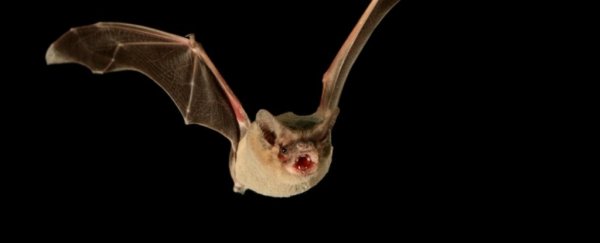Good news: one of our fellow mammals – the Brazilian free-tailed bat (Tadarida brasiliensis) – just smashed a decades-old record for horizontal flight speed, beating out all of the world's birds.
Before now, the record was held by the common swift, which has a top speed of around 110 kilometres per hour (68 miles per hour), and according to new research, can stay in the sky for a remarkable 10 months straight.
Now, researchers from the Max Planck Institute for Ornithology in Germany have found that Brazilian free-tailed bats, a tiny species of bat that weighs roughly 12 grams (about half an ounce), can reach a top speed of 160 km/h (99 mph).
Even more remarkable, that speed is clocked when flying horizontally instead of, say, in a diving manoeuvre. (Fun fact: the record for diving speed goes to the peregrine falcon, which can reach a top speed of around 389 km/h - 242 mph - thanks its unique aerodynamics.)
The team says that the bat's unique ability to fly faster than anything else stems from its extremely light frame and longer than average wings, though many details on how their flight works are still being figured out.
"Initially, we could hardly believe our data, but they were correct: at times, the female bats, which weigh between 11 and 12 grams, flew at speeds of over 160 kilometres per hour [99 mph] – a new record for horizontal flight," said team member Kamran Safi.
Clocking that speed was not easy for the team, seeing as the animals are so small and – as you now know – fast. To do so, they had to affix tiny, 0.5-gram radio transmitters to a number of Brazilian free-tailed bats that would detach on their own after a few days.
Once these transmitters were attached, the team used a mobile receiver on a small aircraft to monitor the speed, but even that was much harder than anticipated.
"It was not easy for the pilot to follow the fast-flying animals so that we could localise them accurately and measure their flight path continuously," said team member Dina Dechmann.
Their persistence eventually paid off, and they were able to accurately clock the little mammal's speed, finding that it is the fastest flier on Earth.
Next up for the team is to figure out how exactly the small creatures are able to perform so well, though they already have some ideas.
"The main contributing factors here are the animals' aerodynamic, projectile-like body shape and their low weight due to special bones," the team said.
"Moreover, the narrow wings found in faster-flying species also enable greater lift relative to the aerodynamic force invested."
While you might think the bats might be using some sort of wind current to increase their speed, too, the team doesn't think that's the case.
"External factors like landscape and tailwinds cannot explain these results, as they had no impact on the maximum speeds," Dechmann explains.
While crowning a new animal speed champion is awesome in itself, gaining a better understanding of how bats and birds fly so quickly with minimum energy can seriously help us design better aircraft.
For example, birds are able to jump right into flight without needing to gain speed, which – if possible – would be absolutely astounding for human aviation to achieve.
The team's work was published in The Royal Society.
